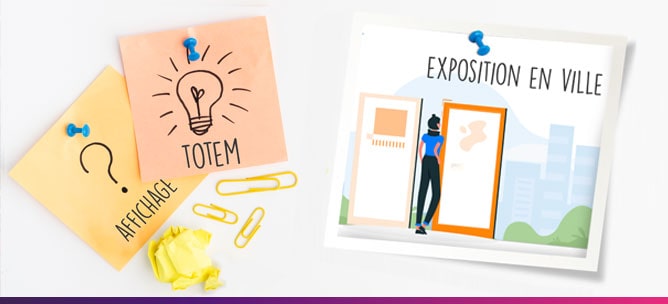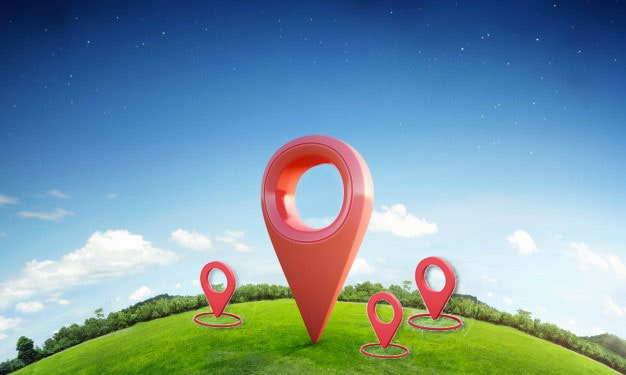How to choose the right totem display for your outdoor signage or exhibition?

As a communicator, you have a general understanding of the various communication supports that should be carefully chosen to achieve your objectives. When it comes to city communication, the questions arise: how to choose your urban signage? What are the constraints? How to distinguish between different totem solutions? Therefore, we offer you a checklist to give you the keys to choosing the appropriate display device for your use and your project.
1. Clearly define your outdoor communication project
Before embarking on research for urban signage solutions, it is essential to define your project. The first questions to ask are:
- What is the objective of this urban communication project?
- Define it: is it to orient the public, guide them, inform them, entertain them, surprise them…?
If several intentions are always present in any exhibition, dominant ones will appear.
- What do you want to highlight? An artist, an urban project, a theme you wish to raise awareness about…? In other words, the message must be simple and accessible to find its audience.
If you are well advanced with your content, it is interesting to estimate the communication surface you will need:
- Format of your content: portrait/landscape
- Dimensions of the visuals
- Number of visuals / Number of information panels
Now that you have the concept, it is necessary to check that the totem solutions or any other display devices you find apply to your context of use.
2. Identify the location(s) and installation constraints
Any exhibition, regardless of its type, requires a connection between the content and the means of presenting it.
It is necessary to visualize where you want to install the displays to optimize their visibility to your target audience.
Next, you can start imagining your urban scenography. The idea is to define a circulation space to invest in and identify any constraints.
Some questions to ask about setting up your outdoor exhibition:
- How do you want the public to discover your project or the theme of your exhibition? The key concepts are: visit route, circulation direction…
The idea is to put yourself in the public’s shoes, what is your desired staging?
- What brand image do you want to convey through the design of the display device?
- What are the possible implementation constraints?
- Physical: obstacles to the visibility of your display (trees, slope, type of ground…)
- Regulatory: passage unit to be respected for free circulation…
This analysis can already help you better understand the shapes of your display (number of faces, rectangular arrangement, square…).
In summary, your focus should be on how you will tell your story and on the layout in the space of your outdoor exhibition supports.
The other central point of your analysis is the definition of your use and your frequency of use.
3. Is your use of the totem event-based, temporary, or permanent?
Your use and its duration over time will guide your choice on the structure of your urban signage.
Three types of use can be distinguished:
- Need for temporary outdoor signage for a short-term event (1 day, 3 months…)
- Need for urban signage for a defined longer period (for 9 months, more than 2 years) to communicate during an urban project
(examples: urban development project, real estate program…)
The communication can then be evolving. You may need to update the communication support.
- Need to equip yourself with urban signage
In this case, the structure will be reused, and the visual will be changed. This may involve relocating the device to another site and/or a storage space for later use.
The use and duration of the device outdoors are important data that will allow the signage expert you consult to recommend:
- The printing support (durability, weather resistance, maintenance…) and treatment: rigid support (wood, Dibond, PVC…), flexible support (printed canvas…)
- The supporting structure of the communication support (totem, hoarding, panel…
For example, for public communication, outdoor signage can be a communication tool to maintain a link with residents and inform them about actions conducted by the city.
If the totem is used as urban furniture that is part of the city’s equipment, it allows for evolving communication according to the city’s program. This is then a completely different approach to the product at the structural level. It can allow, for example:
- Autonomy in managing communication: simple handling of the structure…
- Mobile solution
The structure is designed to be transported using equipment (pallet truck or other).
The choice of your display solution and its implementation are guided by aesthetic, technical, and practical criteria. To these are now added environmental criteria.
4. Choose an environmentally friendly solution integrated into urban ecology
If your activity and therefore your communication is committed to sustainable development, choosing a responsible communication solution represents a concrete action of your commitment.
Basic principles of responsible outdoor communication:
- Take into account the urban ecology of your environment so that the totem aligns with your values.
- Base your choice on materials and products that are minimally processed, that is, with simple processing methods, like raw stone, wood, bamboo, which generally have a lower ecological impact.
- Analyze the entire life cycle to evaluate the environmental impact:
- Favor French manufacturing
- Choose solutions considering the possibilities of direct or partial reuse
- Find out about material recovery at the end of life and possible recycling
- Apply this reflection to the printing support
Examples of actions: printing on wood, giving a second life to printed canvas…
In conclusion, these 4 main criteria allow you to identify your functional needs and determine the relevant signage solutions for your project.
Choosing the right totem really boils down to your needs, your communication/exhibition project, and your brand positioning.
Contacting an expert signage partner remains essential. Their role will be to:
- Analyze the technical installation constraints (fixing method, ground-sealed or freestanding display…)
- Advise you on the most technically suitable display solution or for the design of a custom totem
- Propose a design that aligns with your brand identity (eco-responsible product approach…)
- Respect your specifications, budget, and deepen the project
- Ensure the safety of the proposed devices (wind resistance…) and compliance with safety standards
For more information on outdoor signage solutions, you can consult our solutions. For a custom design of urban signage, we invite you to contact us directly.
Want to know more about urban signage solutions and discuss your project?

